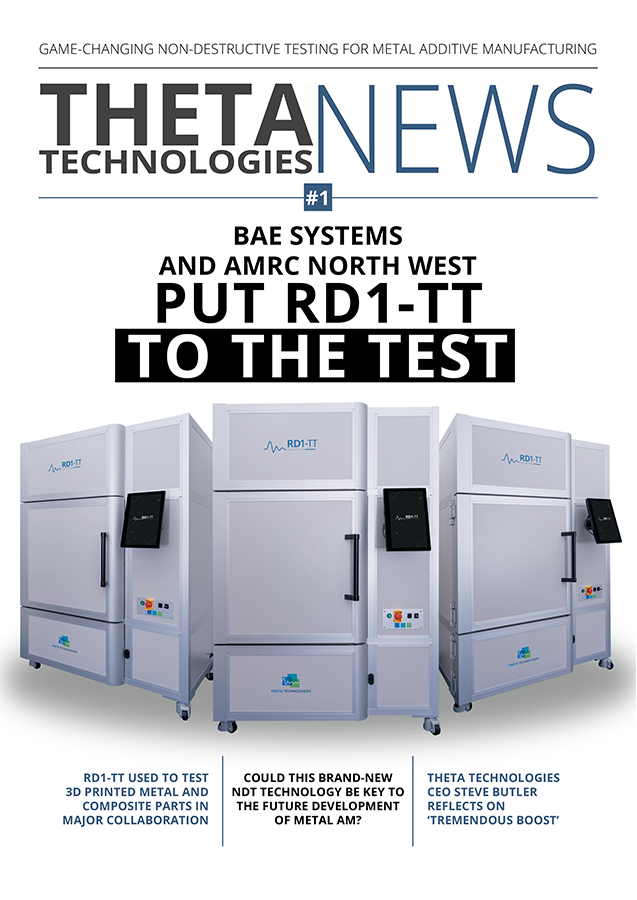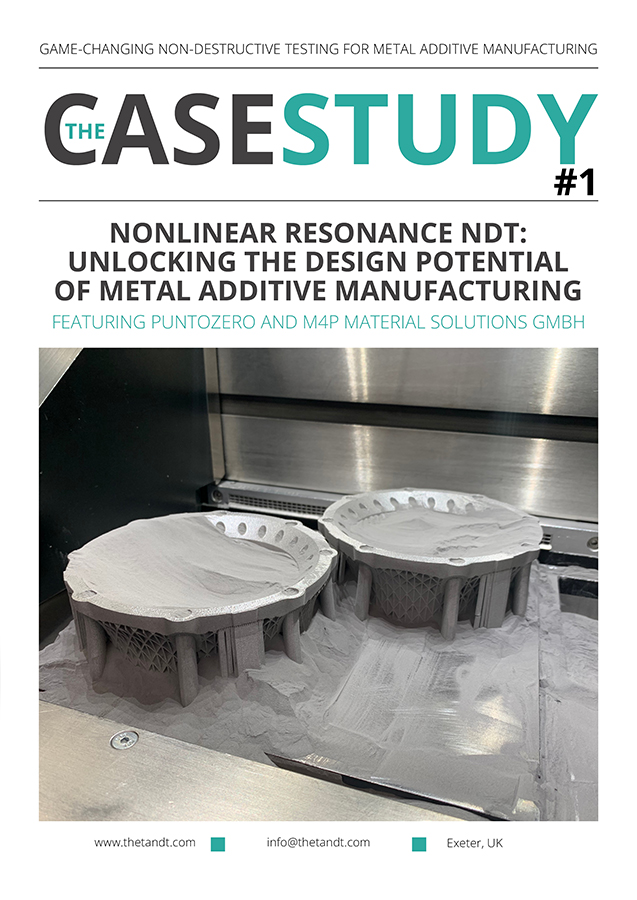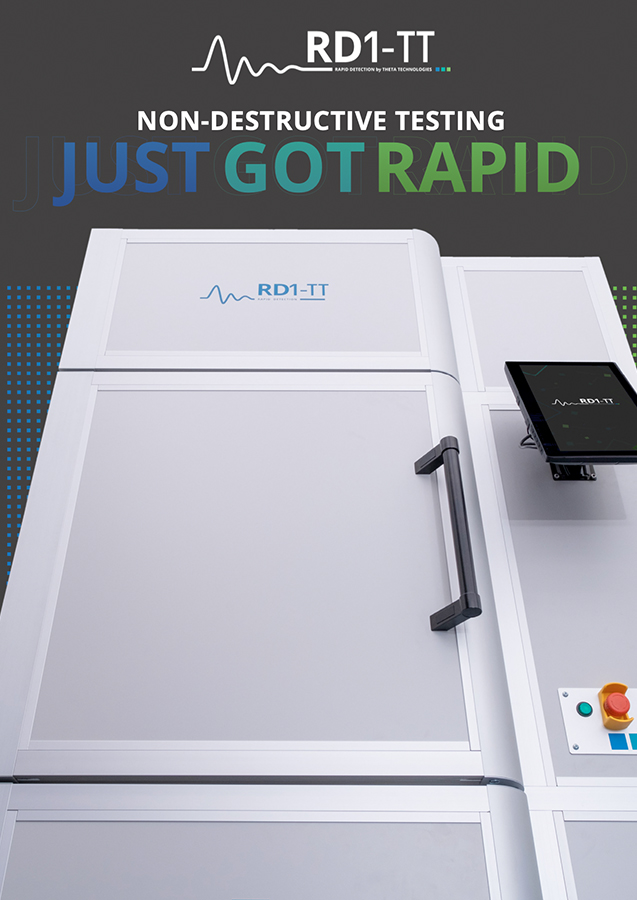The Case Study
Issue 2
Nonlinear Resonance NDT: The Rapid Assessment of Creep in Nickel Superalloy Turbine Blades
We assess how nonlinear resonance can help identify creep with the goal of preventing the unnecessary replacement of perfectly viable components during routine maintenance.
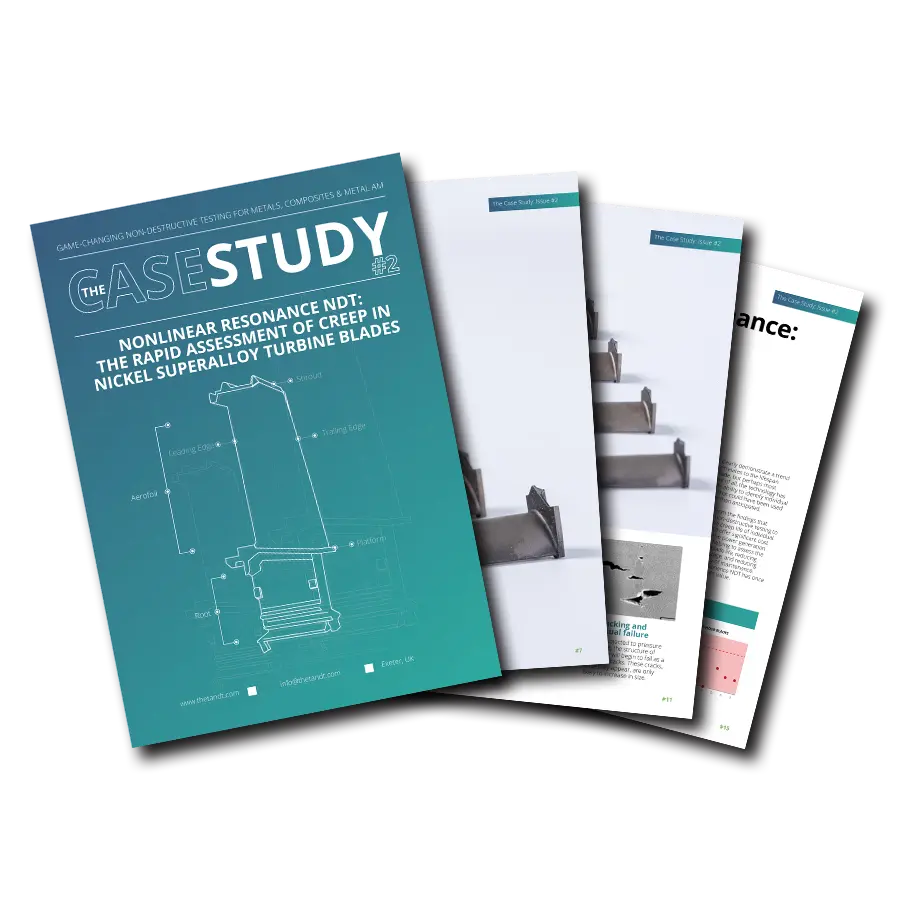
The importance of non-destructive testing
Why NDT is a must for manufacturers of safety-critical components
For those manufacturing components destined for use within demanding and safety-critical applications in industries such as aerospace, defence, automotive or power generation, non-destructive testing is a must. NDT is available in many forms, ranging from simple visual inspection techniques, to more complex and conventional methods like X-ray CT scanning, and now the revolutionary nonlinear resonance NDT technique bought to you by Theta Technologies. We shall explore the benefits of this game-changing technology throughout. Unlike its destructive counterpart where are part is destroyed to test its viability, non-destructive testing allows manufacturers and their customers to test components for flaws that may compromise their integrity without destroying a perfectly useable part.
Why do parts need to be tested for flaws?
The requirement for testing is almost entirely dependent on the future use of the component, but it should be a fundamental step in the manufacturing process to ascertain whether metal and composite parts are produced for applications where failure could pose a significant risk to life or the environment. Even the smallest of flaws within the structure of a component could have a detrimental effect on the part’s ability to withstand the pressures associated with use. You only have to imagine the potential consequences should a defective part prove to be essential to the function of a commercial aircraft for example. Failure is simply not an option and non-destructive testing is used to help identify those potentially detrimental flaws before they become an irreversible problem.
- Rapid Testing
- Can identify flaws other methods cannot
- Test parts with complex designs
- No need for reference parts
- No need for highly trained operators
- No problem with surface roughness
Theta Technologies’ rapid NDT method is ideal for manufacturers looking to scale up production and ensure that every part shipped to their customers is flaw-free.
How does nonlinear resonance NDT work?
Nonlinear resonance is designed to exploit microscopic behaviours of flaws within a component. Parts are excited into resonance and a detector system assesses for nonlinearity. Flawed samples would exhibit an amplitude-dependent frequency response. The very nature of the technology renders it extremely effective for the testing of conventional metals, 3D-printed metals, composites, and even some ceramics.
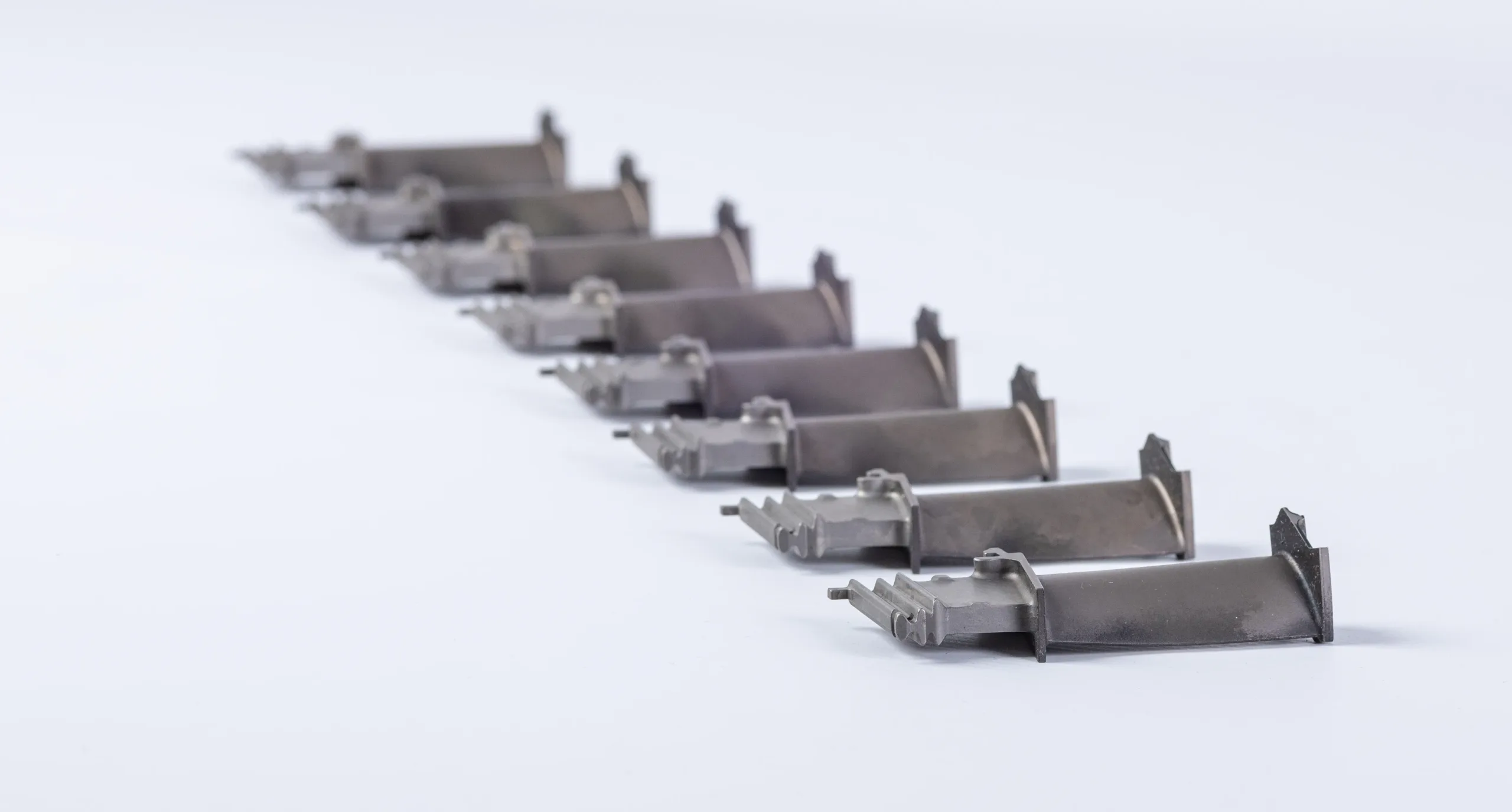
The rapid assessment of nickel superalloy turbine blades using nonlinear resonance NDT.
Using non-destructive testing to prolong the lifespan of key components.
In this case study, we look closely at the benefits of deploying non-destructive testing to detect a defect known as creep in nickel superalloy gas turbine blade samples.
Theta Technologies’ unique nonlinear resonance NDT technique is put to the test to help identify the severity of this common defect within a batch of turbine blade samples at various stages of their life cycle, all in an attempt to help extend their realistic usability beyond conservative estimates.
Theta Technologies continues to work with customers to develop their technology further and validate nonlinear resonance as a reliable method of non-destructive testing for manufacturers; particularly those working with safety-critical applications.
In a recent project collaboration, nonlinear resonance NDT was put to the test for the inspection of gas turbine blades that were destined for use inside power generation engines. The inspection of these turbine blades using traditional non-destructive testing techniques has faced a number of significant obstacles; Speed and cost to name just two, but the main challenge for inspecting components of this nature is linked with the complex geometry. This is attributed to the aerofoil structure of the blade featuring varying levels of curvatures on each side, and differing levels of thickness along the length. The overall test process of turbine blades involves the inspection of features such as cooling channels or fir tree roots. With this study alone, Theta Technologies was able to prove the credentials of nonlinear resonance NDT in testing across the life cycle of gas turbine blades, including those that have been in service for over 30,000 hours.
There are several key factors that make the testing of gas turbine blades so important. When in use, each part is subjected to extremely high mechanical loads due to centrifugal forces (typically 2000-4000rpm). Blades situated in the hottest section of the engine are also exposed to extremely high temperatures; often exceeding 1000 degrees Celsius. The very nature of this intense operation can lead to changes in the sample’s microstructure over time.
More commonly known as creep, the blades are at heightened risk of changing shape during operation, and subsequently in need of close monitoring.
Turbine blades are often retired from service using conservative estimates of their lifespan, usually based on a total number of hours. It is probable however, that parts could be used for much longer than anticipated. Deployment of an effective non-destructive testing solution at the maintenance stage could both prolong the life of the components and have significant cost-saving benefits.
…the ability to predict creep life of the blades to extend their lifespan could significantly reduce costs.
The approximate cost to overhaul a two-spool commercial engine is upwards of £250,000. The maintenance process typically involves the removal of
high-pressure turbine blades, a detailed inspection, and the replacement of any defective blades. This would typically take close to a month to complete at a cost of around £1000 per blade. With around 70 blades in the hottest part of the engine, that’s a significant proportion of the overall cost, and as we’ve already covered, replacements may not be entirely necessary.
With cost very much at the forefront of minds in the current economic climate, the ability to predict the creep life of the blades in order to extend their lifespan could help significantly reduce costs. Maintenance frequency would also likely be minimised, subsequently reducing the operating cost for power generation, or reducing overall risk for aviation.
The objective
As part of the project to help validate nonlinear resonance’s ability to test and predict creep within nickel turbine blades, Theta Technologies were given access to a control sample set. This included newly manufactured turbine blades, mid-life blades, and blades that were approaching their estimated hourly end-of-life threshold.
The aim of the work was to develop a test system that was capable of grading turbine blades according to their creep life. In order to do this, the following steps were taken:
Review literature to identify typical features in the micro structure associated with the creep life of the blades.
Develop a nonlinear resonance ultrasound experimental setup and carry out the non-destructive testing of components
Conduct destructive testing using Scanning Electron Microscopy (SEM)
Could Theta Technologies’ nonlinear resonance non-destructive testing technology help accurately estimate the creep life of the individual components?
Features indicative of creep
Prior to conducting the non-destructive tests, it was vital to outline the features that are indicative of creep in a structure of this nature. Nickel turbine blades are formed of a multi-crystalline structure composed of multiple phases, grain boundaries, and carbide inclusions along the grain boundaries. The structure has anisotropic properties which vary with phase and orientation.
Should a defect be present within the structure of a nickel turbine blade, there is a very notable evolution of that flaw when monitored over time. This typically takes the form of those seen below, the evolution of which can be categorised as the creep life of the blade.
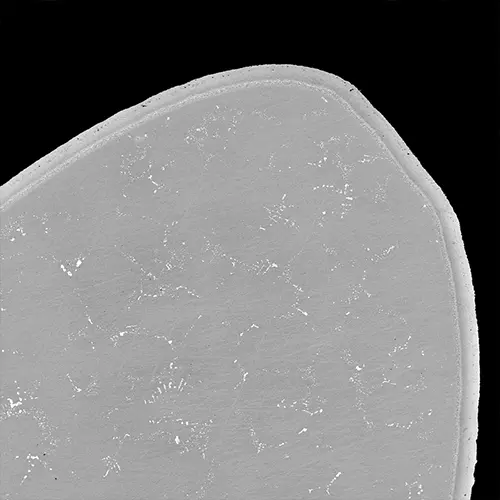
New blade
A newly manufactured blade sample which expectedly displays no evidence of creep within its multi-crystalline structure.
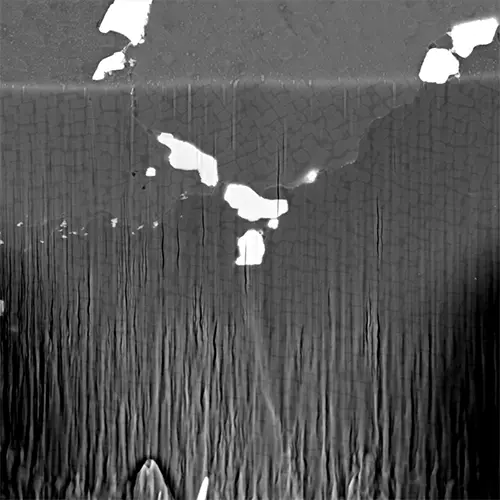
Mid-life blade
In operation for approximately 33,000 hours, the mid-life blades exhibit expected structures. There is clear evidence of rafting but no recrystallisation features observed.
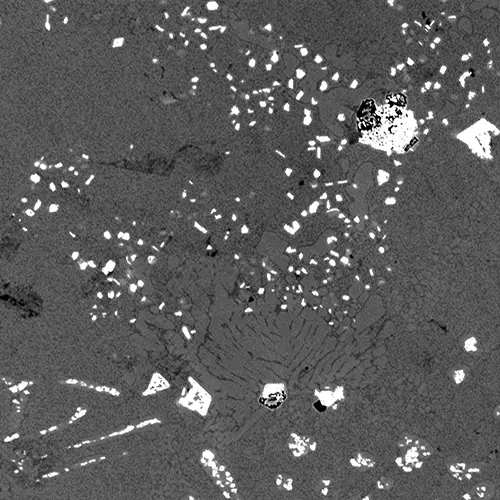
High-hour blade
In operation for approximately 50,000 hours (close to their estimated lifespan), the samples showed volumetric recrystallisation features.
The validation
In addition to the nonlinear resonance test of the turbine blades in this study, SEM pictures were taken of each of the blades across their current life cycle using backscattered electrons. The scans, performed by the University of Plymouth provided detailed imagery of the features within the structure of the turbine blades, which would provide additional validation of the nonlinear results received later in the process.
The nickel turbine blades are formed of a multi-crystalline structure which is composed of multiple phases (γ, γ’, and Eutectic), grain boundaries, and carbide inclusions along the grain boundaries, which helps to stabilise the structure. The blades also have anisotropic properties which vary with phase and orientation.
Evidenced here are three separate SEM images from new blades, mid-life blades, and those that had been in use close to their estimated maximum number of hours (50,000). All blades exhibited expected multi-crystalline microstructures based on the amount of use they had been subjected to.
Parts could have been used for much longer.
Nonlinear resonance: The test results
As part of the nonlinear resonance non-destructive test, each of the blade samples was assessed using multiple vibration modes, which excited the components into resonance. A laser vibrometer was used for detection and an overall damage index was obtained for each sample based on their nonlinearity. Each test of each blade took just one minute to perform, much quicker than any other non-destructive testing technique available to manufacturers.
A total of 20 blades with varying levels of service hours were subjected to the nonlinear resonance tests, and as the results demonstrate (below), there is clear variation in the structure of the component based on its current usage.
As expected, newly manufactured blades showed no signs of nonlinearity, meaning that no creep was identified in the samples; however, a more significant result of the tests revealed that samples O and P, which had been in use for around 50,000 hours, also showed no signs of creep. Blades approaching this level of use would have been immediately withdrawn as part of the scheduled maintenance work, but as the nonlinear resonance test results reveal, the reality is that these parts could have been used for much longer. On the contrary, using the arbitrary damage index threshold of 300, samples K, a mid-life sample of around 30,000 hours, and sample N, a high-hour sample, showed significant signs of creep and would be retired from use.
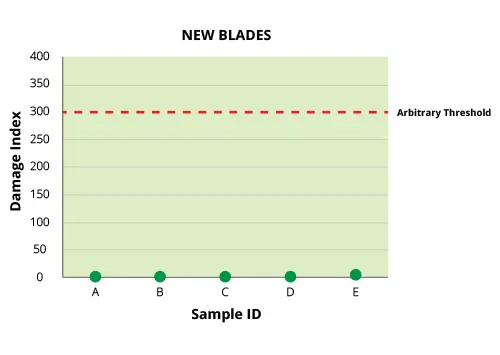
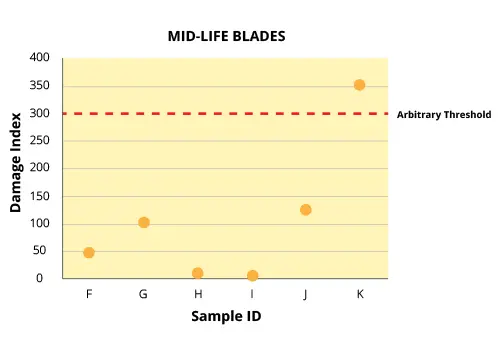
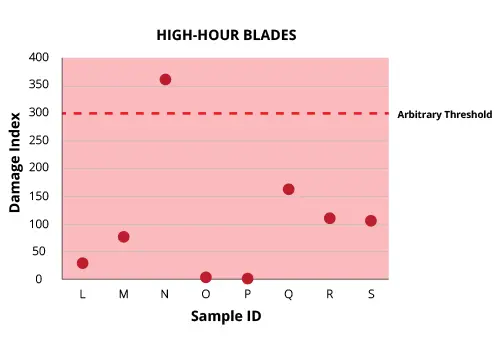
The conclusion
Defects in any shape or form can have a detrimental impact on a manufactured component’s integrity and suitability for use. Creep limits the life of the turbine blades for power generation which in turn increases maintenance and running costs. As wider industry practice, these blades are retired from use based on a conservative estimate of their realistic lifespan rather than having their longevity assessed based on their current operating condition. This means that more often than not, perfectly viable blades are retired from service.
Theta Technologies’ nonlinear resonance non-destructive test results clearly demonstrate a trend that correlates to the lifespan of the blade, but perhaps most important of all, the technology has proven its ability to identify individual samples that could have been used for longer than anticipated.
It is clear from the findings that deploying non-destructive testing to estimate the creep life of individual blades could offer significant cost savings for the power generation industry by helping to assess the anticipated blade life, reducing material wastage, and reducing the frequency of maintenance. Nonlinear resonance NDT has once again proved its value.
other publications
Whether you’re looking to stay up-to-date with our latest news or read about how our game-changing non-destructive testing technology is helping our customers, we’re certain that our rapidly expanding digital publication library has something for you.
Issue #1
Theta Technology News
BAE Systems and AMRC North West put RD1-TT to the test in major collaboration
Issue #1
The Case Study
Nonlinear resonance NDT: Unlocking the design potential of metal AM. Featuring Puntozero and m4p material solutions GMBH
learn more
Find out more about this revolutionary NDT technology from the team that built it.
Theta Technologies Limited

Address
Theta Technologies Limited
3 Babbage Way
Exeter Science Park
Clyst Honiton
Exeter
EX5 2FN
United Kingdom
Terms & Conditions Privacy & Cookie Policy Anti-Slavery Policy © Theta Technologies. 2023

